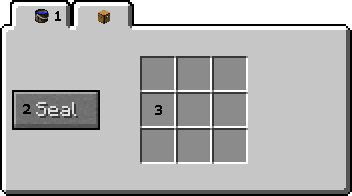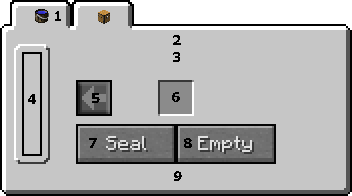User:Kreicus/Temp
| Gravity |
No |
| Tool | |
| Stackable |
Empty: Yes, 4 |
| Flammable |
No |
| Weight ⚖ |
Heavy |
| Size ↕ |
Large |
| BlockID |
terrafirmacraftplus:492:1 |
| Sealed large ceramic vessels will overburden players if not worn on the back. | |
Obtaining
Large Ceramic Vessels are crafted with clay. Clay objects are created using an interface similar to knapping. To open this interface, you must right-click with a stack of 5 or more clay.
Usage
Large vessels are filled with liquids by either placing a full bucket inside the large vessel, by right-clicking on the large vessel with full bucket in hand, or by right-clicking on another filled barrel/large vessel or liquid source block with the empty large vessel in hand.
Once sealed, a large vessel can be broken down and moved. It will retain its contents, allowing the player to fill it in one location before moving it to another. If the large vessel is not sealed when it is broken, it will dump its items onto the ground, and the liquid inside will be deleted. Sealed large vessels must be carried one at a time in the characters back slot (located to the right of the chest armor slot). If the player has a sealed large vessel in their inventory that is not located in the back slot, the player will see a message stating, "Overburdened" and will not be able to move.
Note: All of the below recipes with the exception of those stating "Full Vessel" are the suggested minimum ratios. Any multiple of these ratios that will fit in the large vessel will work. Liquid is the limiting factor for the majority sealed large vessel recipes, meaning that a large vessel can process the recipe if it has too much liquid, but it cannot process if it has too much of an item.
Interface
Liquid Storage
Item Storage

|
|
Fresh Water
Fresh Water large vessels are used as a starting point for tannins, as storage for drinking water, to quickly cool down heated items, to create jute fibers, to process sugar cane, and to turn scraped hides into prepared hides. An unsealed large vessel can be placed outside with direct access to the sky, and will accumulate fresh water when it is raining. A full fresh water large vessel will fill 5 Ceramic Jugs; or can process 25 jute, 83.33 oz of sugar cane, 16 small scraped hides, 12 medium scraped hides, or 10 large scraped hides.
| Jute | Sugar | ||||||||||||||||||||||||||||||||||
|---|---|---|---|---|---|---|---|---|---|---|---|---|---|---|---|---|---|---|---|---|---|---|---|---|---|---|---|---|---|---|---|---|---|---|---|
|
| ||||||||||||||||||||||||||||||||||
| Small Scraped Hide | Medium Scraped Hide | Large Scraped Hide | |||||||||||||||||||||||||||||||||
|
|
| |||||||||||||||||||||||||||||||||
Vinegar
Vinegar is created by adding a large enough piece of fruit to an alcohol large vessel, and then sealing the large vessel for 8 hours. Fruit is the limiting factor in this recipe, meaning that for every 1,000 mB of alcohol in the large vessel, there must be at least 10 ounces of fruit in the input slot. Adding an excess of fruit will simply consume the entire fruit in making the vinegar. While alcohol cannot be made in large vessels, you can fill a large vessel with alcohol by right clicking an alcohol barrel with the large vessel.
| |||||||||||
Brine
Brine is created by adding a single bucket of vinegar to a large vessel containing at least 1 bucket (4,000 mB) of salt water. The recipe is instant, and does not require the large ceramic vessel to be sealed.
| |||||||||||
Usage
Brine can be used with any type of food except for those in the grain category. To brine a piece of food, first make sure that there is enough liquid in the large vessel to brine the weight of the food. If there is not, either add more brine to the large vessel, or cut the food into smaller pieces. While it requires 600 mB of brine for every 10 ounces of food in order to start the process, only 60 mB of the brine will be consumed for each item sealed in the large vessel, regardless of its weight.
| |||||||||||
Pickling
Vinegar can be used to pickle any piece of brined food. To pickle a piece of food, first make sure that there is enough liquid in the large vessel to pickle the weight of the food. If there is not, either add more vinegar to the large vessel, or cut the food into smaller pieces. While it requires 1,000 mB of vinegar for every 16 ounces of brined food in order to start the process, only 1 mB of the vinegar will be consumed for each ounce of the item sealed in the large vessel.
Once a piece of food has been pickled, it can be stored in a sealed vinegar large vessel indefinitely to drastically reduce the rate at which it decays. Storing pickled food in vinegar requires a minimum of 1,000 mB of vinegar for every 32 ounces of pickled food.
| Pickling | Storage | ||||||||||||||||||||||
|---|---|---|---|---|---|---|---|---|---|---|---|---|---|---|---|---|---|---|---|---|---|---|---|
|
| ||||||||||||||||||||||
Limewater
Lime water is created by placing flux in a fresh water large vessel, using a ratio of 2 flux for each bucket (1,000 mB). Lime water creation is instant, and will consume the flux the moment the ratio is valid. Large vessels contianing lime water are used to create mortar and turn raw hides into soaked hides. A full lime water large vessel can process 800 mortar, 16 small raw hides, 12 medium raw hides, or 10 large raw hides.
| |||||||||||
| Mortar | Small Raw Hide | Medium Raw Hide | Large Raw Hide | ||||||||||||||||||||||||||||||||||||||||||||
|---|---|---|---|---|---|---|---|---|---|---|---|---|---|---|---|---|---|---|---|---|---|---|---|---|---|---|---|---|---|---|---|---|---|---|---|---|---|---|---|---|---|---|---|---|---|---|---|
|
|
|
| ||||||||||||||||||||||||||||||||||||||||||||
Tannin
Tannin is created by placing a single Oak, Birch, Chestnut, Douglas Fir, Hickory, Maple, or Sequoia logs in a fresh water large vessel and sealing it for 8 hours. A single log is enough to turn any large vessel with at least 1 bucket (1,000 mB) of fresh water into tannin. Adding additional logs will result in either the recipe being unable to process (shown by no message at the bottom when sealed), or the excess logs will simply be consumed. Tannin is used to tan prepared hides into leather. A full large vessel of tannin can process 16 small prepared hides, 12 medium prepared hides, or 10 large prepared hides, producing 16 leather for small, 25 leather for medium, and 30 leather for large.
| |||||||||||
| Small Prepared Hide | Medium Prepared Hide | Large Prepared Hide | |||||||||||||||||||||||||||||||||
|---|---|---|---|---|---|---|---|---|---|---|---|---|---|---|---|---|---|---|---|---|---|---|---|---|---|---|---|---|---|---|---|---|---|---|---|
|
|
| |||||||||||||||||||||||||||||||||
Curdled Milk/Cheese
Curdled milk is created by adding a single bucket of vinegar to a large vessel containing at least 1,000 mB of milk, and sealing it for 8 hours. This will result in an amount of curdled milk equal to the original volume + 111 * (original volume / 1000).
For example: Adding vinegar to 1,000 mB of milk will result in 1,111 mB of curdled milk. Adding vinegar to 2,000 mB of milk will result in 2,222 mB of curdled milk. The exception to this calculation is adding vinegar to 4,000 mB of milk will result in a 4,444 mB of curdled milk.
After the milk has curdled, remove the empty bucket and seal the large vessel for an additional 8 hours. The weight of the resulting cheese is dependent on the amount of curdled milk in the large vessel, calculated with the formula (Volume mB) * 1 oz / 62.5 mB = Weight oz.
For example: Using the three above examples of curdled milk, would result in 17.77 oz, 35.55 oz, and 71.10 oz of cheese respectively.
| Curdled Milk | Cheese | ||||||||||||||||||||||
|---|---|---|---|---|---|---|---|---|---|---|---|---|---|---|---|---|---|---|---|---|---|---|---|
|
| ||||||||||||||||||||||
History
| Beta | ||
|---|---|---|
| 79.0 | Added Large ceramic vessels. | |
| 79.5 | Large ceramic vessels can be filled from other barrels and large vessels. They can also be emptied into other barrels and large vessels via right clicking on the block. | |
| 79.7 | Can now make cheese in the large vessel. | |

